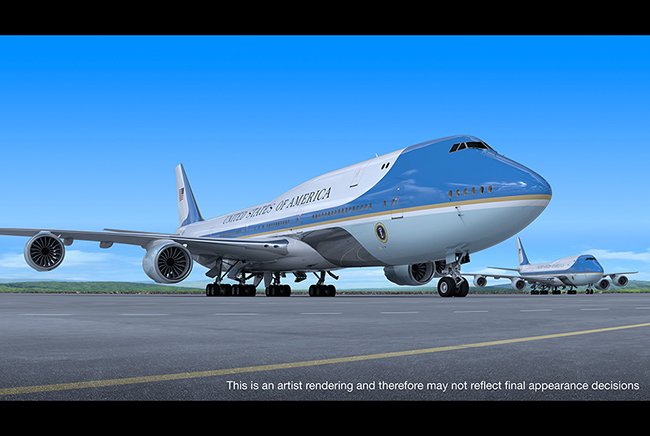
A proposed design for the VC-25B is shown in an artist's rendering. Boeing graphic.
This story was updated to fully reflect a recent Air Force cost estimate.
The next Air Force One jets will cost $5.2 billion overall, according to the Pentagon’s first formal acquisition report on the presidential aircraft.
That’s about the same as the total cost the Air Force provided to Defense One in March, which is significantly more than previous projections. The $4.7 billion development cost listed in the service’s fiscal 2020 budget covers the price of the jets, while the $5.2 billion also includes the cost of hangar construction, engineering, and more.
In 2016, the Government Accountability Office projected the Presidential Aircraft Recapitalization program would total $3.2 billion through 2020, including development and procurement.
Two converted Boeing 747-8s—dubbed VC-25B—will replace older jets as the “flying White House” in 2024. The airframes were built for a now-bankrupt Russian airline but were never delivered. In early 2017, President Trump said he negotiated with Boeing to lower the price by about $1 billion; the Pentagon said last summer Boeing would receive $3.9 billion to build the two jets.
Also notable: the Air Force more than doubled its spending estimate for Lockheed Martin’s Joint Air-to-Surface Standoff Missile to match a planned jump in the number of weapons it will buy, according to a summary of the Pentagon’s most recent Selected Acquisition Reports. The JASSM program is slated to grow from $4.7 billion to about $10 billion as the stockpile grows by more than 4,000 missiles to total 7,200 weapons.
The Air Force’s 2020 budget, released in March, said 7,200 missiles will cost $9.4 billion—about $500 million less than is listed in the SAR summary. The program includes the baseline variant, an extended-range variant, and an “extreme-range” variant called the AGM-158D.
JASSM is the Air Force’s stealthy, long-range conventional cruise missile, which would be a key munition in a campaign against a modern air defense system. Its stockpile projection indicates the Air Force is taking steps to complement its stealthy fifth-generation fighters and bombers with similarly low-profile weapons. JASSM variants will fly on the B-1, B-2, B-52, F-15, F-16, and F-35, according to Lockheed.
The SAR summary also shows the National Security Space Launch program will cost about 7 percent more, totaling $61.3 billion, as the Air Force seeks new rocket providers and plans to need 179 launch services. The Joint Direct Attack Munition program will also grow about by 34,000 tailkits to total more than 370,000 units for $12.5 billion.
The slate of major Air Force acquisitions—not all of which are covered in the summary—are now planned to cost about $270 billion as of March 11, a 5.6 percent increase over the last reporting round.